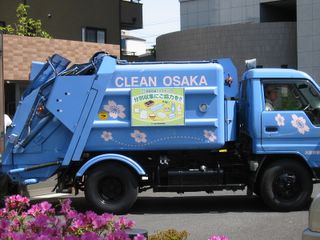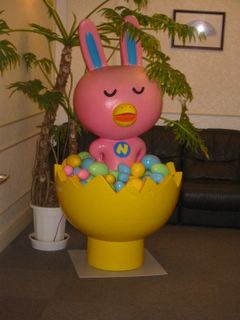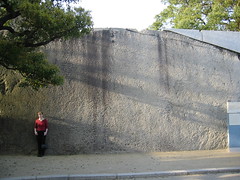I'm sure most of you wonder 'What exactly does an English teacher do?' and 'What does Colleen do all day?' In fact, I bet it is such a perplexing question that you lay awake nights, contemplating the cosmos, begging for answers that will not come. It might even bother you to such an extent that you ponder those questions all day, every day, 'What does Colleen do?' until you cannot even focus on your own job anymore and will soon be seeking employment overseas yourselves. Well, fear no longer Gentle Reader, I am about to take you on a journey through my world.
Let's start with the blog's title. The
Nova usagi is pink beak-faced bunny. Every day it greets me, popping out of it's egg-filled...egg (don't ask) with an enthused grin on it's face. In a country that doesn't celebrate Easter (you try explaining Easter to a Buddhist...heck you try explaining it to a North American and see how far you get) it is an odd symbol. But this beak-faced bunny has rejuvenated the Nova image, bringing in students, and more importantly, merchandising money. The bunny is a popular character here in Japan. It's little beaked-face can be found on clocks, key-chains, lamps, and many other products that have nothing to do with learning English. Bunny toy sales brought in millions of yen, and it (the bunny) even had a Top 10 CD. The public face of the company I work for is pink, beak-faced bunny, and it's everywhere! Run for your lives people! The bunny is coming for you too!! The bunny is coming! The BUNNY IS COMING!!!
Actually, the bunny was quite popular a couple years ago, but like many animated fads it faded quickly. You can still see the bunny in many places. But most Nova ads are right now are done by a tuxedoed opera singer. But the bunny did help Nova stay on top as Japan's leader of language education. And it still greets me everyday as I go to work. Beating me into subservience with it's effulgent, effluent joy. Damn you bunny, stop eating my BRAIN!!!
Anyway, back to Nova. Nova is Japan's leader, not only in English education, but also in language education. Our office has English, Spanish, Italian, French, German and Chinese teachers teaching 22 hours a day. Nova has stayed so popular because it markets a very effective method of language education. Every lesson follows the same pattern of Assessment and Focus, Language Input, Tune-In, Listening, and Application (my trainer would be so proud). Every lesson is the same length. Every branch across Japan has a similar layout. And every lesson should be taught in the same way in every branch. Down to the minute. There are allowances for teacher creativity and tailoring the lesson to the student. But one of the big reasons that Nova is so popular is that it is similar to McDonald's method of global domination. Every burger in every chain should be the same. No customer should be surprised with the unfamiliar. And the results should be predictable every time (and I don't mean the flatulence). The assumption, of course, being that every one will learn a language very fast and very easily. And Nova certainly tries to meet that goal.
The upside to such a method is a) it is very effective, and b) I don't have to work too hard. No lesson planning, no marking tests, just simple conversation according to preset plan. My lesson planning consists of the 5 minutes before class as I go through each student's file and pick the best lesson for the group today. And my grading consists of the 5 minutes after class as I write comments about their strengths and weaknesses, and grade them on a drop down list of criteria.
The downside, of course, is that you start to feel like a cog in a giant machine. New teachers are constantly arriving to replace the ones leaving, and you feel a bit expendable. A face in the crowd. A number in a cubicle. Which, according to the computer, is exactly what you are. Language is a commodity, and you are there to serve. Just a pickle in the McDonald's-like monolith of teaching. Would you like fries with that?
Another similarity between the two corporations is well...the
headset. I work in Nova's Multimedia Centre. Which means I sit in front of a computer all day and talk to students from across Japan. They get to learn from the comfort of their bedrooms, dining rooms, or utility closets. And I get to teach from the comfort of a tiny 4'x5' cubicle.
So now you're probably wondering, cubicle? how does that work? Being the generous soul I am, I shall tell you.
I arrive at work at about 2:50 pm, Monday-Thursday and Saturday. The Nova Multimedia Centre operates 22 hours a day (3-5 am is maintenance), 7 days a week. It takes over 700 employees to keep it running 22 hours a day, including tech staff, admin people, and of course teachers. There are over 500 teachers employed at this one Nova branch. As I arrive on the 15th floor I see the happy pink bunny. If you were to walk into the reception area with the bunny, your footsteps on the welcoming mat would trigger a chime in the next room, causing a Nova employee to sit in front of a computer with webcam, put on a headset and cheerily greet you. Her image would appear behind the reception desk on a monitor. Letting you, the customer, know just what a high-tech office we are.
Turning left down the hall, I swipe my way into the
break room with my card key. It's shift change time so the room is crowded with people entering and leaving. Around me people from a dozen different countries are conversing in a multitude of accents and languages. People from all over Asia, the UK, North America, Australia, and Europe work here. Generally language groups tend to flock together, but almost everyone has some level of English, and then there are some multilingual savants out there too.
I walk to the rolling dividers full of time cards and punch in. Then I walk to my little shoe locker, just large enough for my headset, a notepad, my purse and my shoes. I change out of my street shoes and into my indoor slippers. Because we are a showpiece of the Nova corporation many VIP tours come through. To reduce wear and tear on the offices and to reduce the sight of any unprofessional footwear, everyone must change into indoor shoes or slippers at work. It never fails to make me feel like I'm back in kindergarten. Even though my locker has no lock on it, I leave my purse there. I check the monitors that cover one wall of the room. I check to see what booth I start my day at. My name scrolls by and I head down to the 14th floor. There are 3 teaching floors, mine is the only one with a smoking break room. The room is sealed, but it still smells like I work in an ashtray some days, especially when I get one of the lucky booths close to the break room door.
There are no cell phones, food, drink, electronic devices, or manga books allowed on work floors, to help maintain our professional look. Tours come through here often, and sometimes the cameras above us are used to transmit images of us teaching to conferences and meetings. I log onto the computer and check my schedule. I bring up my first lesson and check the student histories, comments, and recommendations from past teachers. I check to make sure I am centered in the camera, do a sound check with my mic, test my electronic whiteboard, bring up my "Colleen will be with you in a moment" opening slide (complete with my smiling face), wait for the clock to count down to 5 minutes, connect to the GingaNet (Nova internet), and wait for the chime. At exactly 3:10 pm a melodic chime sounds on every floor and over the headsets. It is in a different key and tempo on the floor and on my headset, but when they are both done, I put on my best smile and greet my first students of the day. Around me, many voices, in many languages, chime at the same time, 'Hello!'
In one quarter of my screen is the video output. There I see myself and between 1 and 3 students, sometimes 0 with the occasional no-show. Below that is the lesson plan. On the right hand side of the screen is my student comment page, which I add to throughout the lesson. I can also turn the entire screen into the whiteboard display, which I write on the desk with my electronic pen. I also have access to electronic flashcards and sound files to keep the lessons interesting. With all this technology there is bound to be a technical snafu or two. So there is also a button for tech help. That rings a bell on one side of the floor and a tech worker will run to your booth to help fix the problem. Sometimes it's on the student's end, as they have the same camera/connection GingaNet device as we do. But often it's on our end. Tech has 5 minutes to fix the problem before we have to give the student a free lesson. Often it's an easy fix. But we have to keep teaching and smiling into the camera until it is. The show must go on. And it does, for 40 minutes. Then I wrap up, thank the students, finish my comments, hit save, check my next booth number, and it's on to the next lesson.
And that's how it goes for the rest of the day. Sometimes I have the same booth a few lessons in a row, but often I move from booth to booth for each lesson. Sometimes I have free periods not filled with a lesson, but often my only break is lunch. I teach 8 lessons in a day. Then I head back up to the 15th floor. I reverse my morning routine, outside shoes and punch out. And then I'm walking back down to the train station about at about 10:45 pm.
I teach all levels of students, from the never-spoke-an-English-word-before, where I teach them how to say hello and words like shoes and tie, to the almost native speaking level, where we talk about everything from aging to Zen states. My students are all ages, have all kinds of jobs, and live all over Japan. I have taught people from Okinawa to Hokkaido and everywhere in between. Because of the huge number of students that the Multimedia centre services, I seldom have the same students twice. Sometimes I do, and I enjoy seeing their friendly faces again and getting caught up on their lives, but it doesn't really effect how I teach. The students know what to expect, and we follow the plan.
I have had some amusing lessons, but those are stories for another time. This entry was to let you know what I do with most of my time in Japan. Teaching is not my calling, but I don't dislike my job. In fact, when you get those moments when you get a student to think more about a subject then they ever have before, or when they finally understand a sentence you've been working on for 10 minutes, the joy is immediate and my job satisfaction high. Then you just hope it happens during the next 40 minutes.
I have a lot more to share with you all. Sorry this ran so long. The blogs should get shorter the longer we're here. Coming soon...'The Garbageman Cometh!' and 'Samurai Cats!'
Miss you all!



